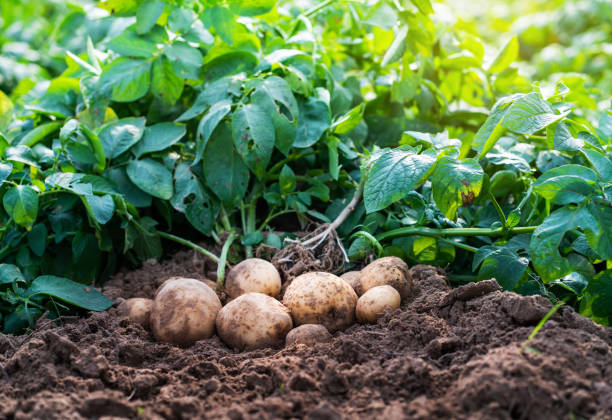Tocosh - Potato

Common Names: Tocosh, Tokosh, Togosh, Tocos, Inca treasure, Fermented potato, Solanum tuberosum, Potato, Peruvian traditional medicine, Quechua origin
Latin Name: Solanum tuberosum
Origin: Asia, Australia, Europe, South America, North America
Short Introduction
Since the source of tocosh is the potato, this crop is well known in temperate regions and can be prepared following individual tradition and experience.
Detailed Description
Tocosh is a traditional Andean fermented potato, regarded as a sacred gift from Inti, the sun god, for the preservation of the body.
Botanical Information
Tocosh available on the market is essentially a white powder made from potatoes (Solanum tuberosum, family Solanaceae), the same species commonly cultivated in modern agriculture. Potato plants feature a square-shaped stem with short hairs and can grow up to 1.5 meters tall. The pinnate leaves are stalked and measure 30–50 cm in length.
The flowers are white, pink, or purple. The plant bears green or yellow-green berries. Underground, the plant develops clusters of tubers in variable shapes—ellipsoid to irregular—with yellow, light brown, or reddish-purple skin.
Origin and Distribution
Solanum tuberosum is one of the most important crops of the Andes, originally grown along the Andean mountains of South America and now widespread worldwide. Over generations, Andean farmers have developed varieties resistant to frost and drought, able to be cultivated at elevations above 3,800 meters. Solanum tuberosum was domesticated nearly 10,000 years ago; ancient Peruvians utilized both the fresh potato and a unique fermented product known as tocosh.
The name 'tocosh' is derived from the Quechua word 'tuqush', meaning 'wrinkled and fermented.'
Usage / Dosage
The fermentation process for tocosh was likely discovered by the Inca or another pre-Columbian culture within the Inca Empire. The Incas believed tocosh was a divine gift from Inti, the sun god, to sustain the body.
Tocosh has a potent aroma and flavor. It is often used as a flour. In Peru, three regions are particularly renowned for producing tocosh: Ancash, Huánuco, and Junín. The most common preparation involves using tocosh flour to make a jelly-like dessert called mazamorra.
Tocosh dishes are often prepared for special occasions and celebrations.
Traditional Medicine and Culinary Uses
In folk medicine, tocosh is celebrated for its effective antibiotic qualities and is also valued as an affordable stimulant and probiotic.
Traditionally, tocosh is used in postpartum care, as well as to treat the common cold, pneumonia, and external wounds. It is also applied in the management of hemorrhoids, gastric ulcers, gastrointestinal infections, altitude sickness, and to protect the stomach lining.
Due to these properties, tocosh is recommended in traditional medicine as a nutritious food for children.
Active Compounds
Chemical analyses of tocosh have revealed the presence of fatty acids, free amino acids, macro- and micronutrients, and vitamins such as thiamine and riboflavin, as well as various minerals. The fermentation process makes these nutrients more accessible in simple, easily assimilated forms. Fermentation also increases linoleic acid and calcium levels.
Potatoes contain steroidal alkaloids that, if not properly stored, may lead to symptoms of poisoning such as respiratory distress, nausea, vomiting, and diarrhea—mainly due to acetylcholinesterase inhibition. The primary steroidal glycoalkaloids in potato tubers are alpha-solanine and alpha-chaconine, glycosylated forms of the steroidal alkaloid solanidine, which can also influence taste.
The concentration of steroidal glycoalkaloids may increase in response to factors such as damage, fungal attack, adverse agricultural conditions, weather, or improper storage.
Currently, tocosh flour and its derivatives are sold as natural products in Peruvian markets. However, there is limited research on its long-term consumption effects. Only one study has assessed the acute and subacute toxicological effects in rats.
Traditional Dosage
Tocosh is produced by naturally fermenting potatoes for medicinal and nutritional purposes. The process involves placing potatoes in pools protected by straw or mesh near a stream for an average of six months before extraction for consumption.
Tocosh is fermented in water for four months to two years. When a foamy layer with a strong, pungent odor rises to the surface, tocosh is ready to be harvested. The mass is then sun-dried and can be eaten directly or stored for later use.
Tocosh flour is believed to help treat gastritis, ulcers, gastroesophageal reflux, and stomach cancer.
Most products on the market recommend a dosage of 1–2 teaspoons added to breakfast, or mixed into tea or another warm drink.
According to folk medicine, a common practice is to dissolve one teaspoon of tocosh flour into 100 ml of water and consume it before meals as an alternative treatment. Traditional medicinal dosages range from 500 to 1000 mg/kg per day (based on interviews with farmers in potato-growing regions).
